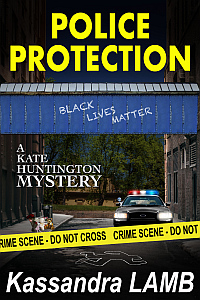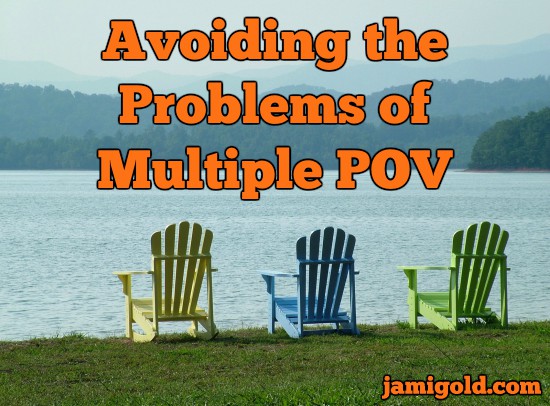As a paranormal romance author, I’m used to writing with multiple points of view (POV), as all my stories feature both of the main characters. But that style of writing isn’t limited just to romance. In many genres, we can include multiple POVs to add depth, layers, insights, and opportunities to our stories.
That said, we also don’t want to use multiple POVs simply as a crutch to avoid head-hopping issues. Just because we want to share how another character feels isn’t usually enough of a reason to change POVs, as we can use craft techniques to provide insights into non-POV-character emotions to readers.
Head-hopping and multiple POV stories are very different, and the first clue is in the name:
- Head-hopping jumps into another character’s head without a transition, often to learn what they’re thinking or feeling.
- Multiple POV stories are more about providing another character’s perspective on the story itself.
In other words, relying on multiple POVs should be a storytelling choice, not just an expedient way to share another character’s emotions.
Any POV type—whether first, second, or third person POV—can use multiple POVs within the story, and those storytelling choices can get complicated. So if we’re going to use multiple POVs, we want to do it “right.”
I’m on vacation this week, but don’t worry. Regular guest poster here Kassandra Lamb (who also writes romance suspense under the pen name Jessica Dale) returns to share her fantastic tips on how to make multiple POVs work for our story, including several do’s and don’ts.
Please welcome Kassandra Lamb! *smile*
*****
How To Write Multiple POVs Right
by Kassandra Lamb
Once upon a time, writing in more than one point of view was a no-no, unless you were writing romance, and then you were supposed to stick with just the hero’s and heroine’s POVs. But it’s becoming more common these days to see stories that include other perspectives, like the villain’s and/or secondary characters.
There are reasons for doing this, but it can get complicated. So it’s important to figure out how to write Multiple POVs right.
Having just completed a ten-book multiple POV series, the subject is on my mind right now. I’ve been contemplating how I naively started with multiple POVs without much pre-thought and now I am deftly (or at least more deftly *grin*) using it for very specific purposes.
So here are some reasons for using multiple POVs and some Do’s and Don’ts for writing it right.
5 Good Reasons to Use Multiple POVs
#1: Character Importance
If you have two characters who are close to equally important to the story, it’s appropriate to show both POVs.
This was my reason for this approach in the first book of my series, Multiple Motives. That story is about two platonic friends, and someone seems to have a murderous grudge against both of them. I wanted to show how the adversities they were dealing with strengthened their friendship, so it seemed appropriate to show parts of the story from each perspective.
#2: Plot Logistics
More than one POV also allows you to show what is happening at times and places when the protagonist isn’t present.
This was critical in Multiple Motives, because at a point in the story, the two friends are separated; one is in danger and the other is trying to find/rescue him.
The only other way to do that would have been to have one of the friends “tell” what happened on their side of things, once the rescue happened—not nearly as powerful as showing what each is going through in real time.
#3: Necessary Insights into Character Motivations
Multiple POVs also allow for showing the motivations of more than one character’s actions.
I ran into this issue with one of my important secondary characters. Not being inside her head when she came to a particular decision would have made her actions seem totally out of character. Again, I could have had her explain her motivation to the others, but that would not have been nearly as powerful as having the reader witness her internal struggle.
#4: Contrasting Perspective
A character’s nature (especially their flaws) can be revealed through another character’s perceptions.
Sometimes giving multiple characters a POV scene can hurt our story, but @KassandraLamb shares 5 situations to use them Click To TweetNothing illuminates a character better than the reader seeing them through another person’s eyes, especially when that is compared to what the character believes about themselves.
In my new release, the last book in the Kate Huntington series, Kate is doing something she feels is necessary to protect others, but those close to her have a different opinion about the wisdom of her actions. Their concerns are summarized in a secondary character’s internal dialogue.
“And Kate’s going to meet this guy by herself?” Judith asked, fighting the urge to shake her head. Kate was a brilliant psychologist, but she sure could be stupid sometimes.
#5: Manage Reader Emotions
Multiple POVs can be used to modulate emotional intensity.
Most of the time, we want readers to feel what the characters are feeling, and just as intensely. However, sometimes this is not desirable.
There are times when we want to back the reader away from the intense emotions.
- One is when the emotions may be too overwhelming for our audience. I can show raw, dark emotions in my romantic suspense stories, for example, but not in my cozy mysteries (thus the different pen name). We don’t want our readers to stop reading because they can’t handle the emotional intensity.
- Another time is when intense emotions would slow down the story’s pace too much.
In both cases, showing the character’s reactions through the eyes of another character can create just the right amount of distance.
In Multiple Motives, Kate’s first husband is the murder victim. I show some of her initial shock and grief through the eyes of her friends and family, both to keep the story from bogging down and to not overwhelm the reader.
While multiple POVs have these advantages, there are some pitfalls to avoid when using this approach.
7 Do’s and Don’ts of Multiple POVs
#1: Don’t Head-Hop
As a newbie author, I didn’t know any better. I had my stories’ POVs ricocheting all over the place. When I finally figured out what I was doing, I rewrote my first few books to clean up the mess.
So what is head-hopping? It’s jumping frequently from one person’s POV to another with no breaks in-between, no transitions, and often for no good reason.
I learned the hard way that this is not true multiple POVs, and it will not help your readers feel closer to your characters. Indeed, it tends to have a distancing effect, as the reader is often confused about whose head they’re in at the moment.
#2: Do Limit the Number of POV Characters
The reader does not need to hear the thoughts of every character.
I was once reading a book, an early work of a well-known author, in which she head-hopped all over the place. At one point, the main character bolts into a road while running away from the villain, and whish, suddenly I’m inside the head of an anonymous cab driver—who never shows up again in the book—and he’s thinking she’s crazy.
Avoid problems when using multiple points of view by following these 7 do's and don'ts from @KassandraLamb Click To TweetTalk about being pulled out of a story. I literally held the book away from me and said out loud, “Say what?”
The author could have so easily shown his reaction by having him yell out his window, “Hey, lady, are you nuts?” But instead I was yanked out of the heroine’s head, and I lost my sense of connection with her fear.
Ask yourself who really needs to have an intimate level of contact with the reader. I try to stick to main characters and important secondary characters, but every once in a while, something just needs to be told through a lesser character’s eyes (but never un-named cabbies!)
#3: Do Clearly Show When POV Changes
Preferably, there should be a definite break in the action, such as a chapter or scene break.
And then ground the reader quickly in the new POV character’s perspective. In the very first sentence of the new section, have that character feel an internal sensation or think a thought.
#4: Do Use Deep POV with Each POV Character
This is not omniscient POV where the narrator tells the reader what various characters are thinking, feeling, etc. This is Deep POV for whatever character is currently in the POV hot seat. Have them sucking in air, clenching their teeth, swallowing lumps in their throats, and talking to themselves in their heads.
I have had many readers comment that they love being able to relate closely to all the important characters in my Kate Huntington books. Don’t cheat your readers out of those close connections.
#5: Don’t Repeat a Scene from a Different POV
You can have a different character react to what happened in a previous scene, but don’t regurgitate the events of that scene. I’m including this because I recently read a book, by a very well-known author, in which she has FIVE different characters flashback to the same scene from their past, and the entire scene is replayed each time!
First Rule of Writing: Do not bore the reader.
#6: Do Have a Character Arc for the More Important POV Characters
Especially in a series, if a character is important enough to have a fair number of POV scenes, then they are important enough to show development, for better or worse, over time.
One of my favorite characters in my Kate Huntington series is Rose Hernandez. She is a short, sturdy young woman with a tough exterior and an overdeveloped sense of duty, loyalty, and fairness.
At the beginning of the series, she shows very little emotion, but the reader sees some of what is going on inside when Rose is the POV character in a few scenes. The pivotal decision that she makes in the first book provides the opportunity to develop friendships, almost despite herself, with the main characters. And over the course of the series, those friendships mellow her, even though she maintains her tough exterior to the rest of the world.
This brings us back to limiting our POV characters. I intentionally decided NOT to give Rose’s love interest, Mac, more than the occasional POV scene, even though he’s a good friend of Kate’s and in every book in the series. There are only so many full-blown character arcs one can manage in one series.
Which brings me to my last point…
#7: Do Make the Time Spent in a Character’s POV Appropriate to Their Importance
In my romantic suspense series, my heroes and heroines get close to equal POV time. The villains get less than either of them, but still much more than the occasional scene from the POV of a secondary character, such as a friend who’s involved in solving the mystery (who may end up being the hero/heroine in another book in the series *wink*).
Readers expect a character with a lot of POV time to be fairly important to the story. If s/he turns out to be little more than a supporting character, the reader will feel off balance, maybe even tricked or cheated.
Hope this is helpful. Anything else you all would like to add about how to write multiple POVs right?
*****
 Kassandra Lamb is a retired psychotherapist turned mystery writer. She spends most of her time with her characters in an alternate universe, the magic portal to which (i.e., her computer) is located in Florida, where her husband and dog catch occasional glimpses of her.
Kassandra Lamb is a retired psychotherapist turned mystery writer. She spends most of her time with her characters in an alternate universe, the magic portal to which (i.e., her computer) is located in Florida, where her husband and dog catch occasional glimpses of her.
She is the author of the Kate Huntington mystery series, the Marcia Banks and Buddy cozy mysteries, plus a guidebook for novice writers, Someday Is Here! A Beginner’s Guide to Writing and Publishing Your First Book. She also writes “edgy” romantic suspense under the pen name Jessica Dale.
Website | Facebook | Pinterest | Goodreads | Twitter | Amazon | Jessica Dale’s Website
*****
 Police Protection: A Kate Huntington Mystery
Police Protection: A Kate Huntington Mystery
A story ripped from real-life headlines!
A groggy police detective is found standing over the body of an unarmed African-American boy, with no memory of what happened. To the police, it’s a slam-dunk. But investigating behind the scenes, psychotherapist Kate Huntington and her P.I. husband determine that whatever happened, it was more than just a bad shoot by a stressed-out cop. The answers may come from unexpected sources, but they’d better find them soon… before another life is lost.
Amazon | Nook | Apple | GooglePlay | All Retailers
Also Mentioned in the Post:
- Multiple Motives: All Retailers
- Jessica Dale’s Binding Vows: All Retailers
*****
Thank you, Kassandra! You covered every caveat and warning and tip I could have thought of…plus a bunch more. This is perfect. *grin*
I hope Kassandra’s insights help clarify how multiple POV isn’t omniscient and isn’t head-hopping, and it isn’t “legit” POV changes just to avoid headhopping either. There are times our stories need multiple POVs, and those reasons are completely separate from the other issues.
For an example of another writing issue multiple POVs can create in our stories, repetition is a problem that can be found in many levels of our writing, from word echoes to theme development. So while there are obviously exemptions to Kass’s tip #5 about not repeating the scene in another POV (such as when contrasting perspectives is the point of the story), that’s usually not the case.
I’ve seen some authors repeat the events in the last paragraph or so of one scene in the next, but the technique always pulls readers out of the story by “rewinding” a bit, and in the vast majority of those examples, the repeat probably wasn’t necessary. The impact of pulling readers out of the story increases if the repetition is even longer than just a sentence or two.
Misusing the technique of multiple POVs can ruin pacing, tension, and subtext—often by making information too explicit and removing the mystery from readers’ interest in the story. But if we follow Kassandra’s tips, we’d avoid most problems with multiple POVs. Using multiple points of view can be good for our stories…if we know what we’re doing. *smile*
Do you like reading stories with multiple points for view? When does it work or not work for you? Have you written stories with multiple points of view before? Did you struggle with figuring out when or how to switch POVs? Can you think of any other insights or advice for writing multiple points of view, or do you have any questions for Kassandra?

